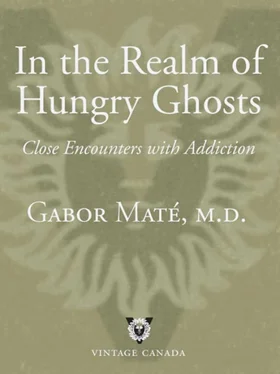9. M.H. Teicher, “Wounds That Time Won’t Heal: The Neurobiology of Child Abuse,” Cerebrum: The Dana Forum on Brain Science 2(4) (fall 2000).
10. A. de Mello A et al., “Update on Stress and Depression: The Role of the Hypothalamic-Pituitary-Adrenal (HPA) Axis,” Revista Brasileiva de Psiquiatria 25(4) (October 2003); see also G.W. Kraemer et al., “A Longitudinal Study of the Effect of Different Social Rearing Conditions on Cerebrospinal Fluid Norepinephrine and Biogenic Amine Metabolites in Rhesus Monkeys,” Neuropsychopharmacology 2(3) (September 1989): 175–89.
11. Teicher, “Wounds That Time Won’t Heal.”
12. B. Perry and R. Pollard, “Homeostasis, Stress, Trauma and Adaptation: A Neurodevelopmental View of Childhood Trauma,” Child and Adolescent Clinics of North America 7(1) (January 1998): 33–51.
13. G.W. Kraemer et al., “Strangers in a Strange Land: A Psychobiological Study of Infant Monkeys Before and After Separation from Real or Inanimate Mothers,” Child Development 62(3) (June 1991): 548–66.
14. L.A. Pohorecky, “Interaction of Ethanol and Stress: Research with Experimental Animals:—An Update,” Alcohol & Alcoholism 25(2/3) (1990):263–76.
15. S.R. Dube et al., “Childhood Abuse, Neglect, and Household Dysfunction and the Risk of Illicit Drug Use: The Adverse Childhood Experiences Study,” Pediatrics 111 (2003): 564–72.
16. Harold W. Gordon, “Early Environmental Stress and Biological Vulnerability to Drug Abuse,” Psychoneuroendocrinology 271(2) (January-February 2002): 115–26. Special Issue: Stress and Drug Abuse.
17. S.R. Dube et al., “Adverse Childhood Experiences and the Association with Ever Using Alchohol and Initiating Alcohol Use During Adolescence,” Journal of Adolescent Health 38 (2006).
18. C.M. Anderson et al., “Abnormal T2 Relaxation Time in the Cerebellar Vermis of Adults Sexually Abused in Childhood: Potential Role of the Vermis in Stress-Enhanced Risk for Drug Abuse,” Psychoneuroendocrinology 27 (2002): 231–44.
19. Teicher, “Wounds That Time Won’t Heal.”
20. M.D. De Bellis et al., “Developmental Traumatology Part I: Biological Stress Systems,” Biological Psychiatry 45 (1999): 1271–84.
21. M. Vythilingam et al., “Childhood Trauma Associated with Smaller Hippocampal Volume in Women with Major Depression,” American Journal of Psychiatry 159: 2072–80.
22. Teicher, “Wounds That Time Won’t Heal.”
23. E.M. Sternberg, moderator, “The Stress Response and the Regulation of Inflammatory Disease,” Annals of Internal Medicine 17(10) (15 November 1992), 855.
24. A. Kusnecov and B.S. Rabin, “Stressor-Induced Alterations of Immune Function: Mechanisms and Issues,” International Archives of Allergy and Immunology 105 (1994), 108.
25. Hans Selye, The Stress of Life, rev. ed. (New York: MacGraw-Hill, 1978), 4.
26. Dr. Bruce Perry, interview by author.
27. M.D. De Bellis et al., “Hypothalamic-Pituitary-Adrenal Axis Dysregulation in Sexually Abused Girls,” Journal of Clinical Endocrinology and Metabolism 78(1994): 249–55.
28. M.J. Essex et al., “Maternal Stress Beginning in Infancy May Sensitize Children to Later Stress Exposure: Effects on Cortisol and Behavior,” Biological Psychiatry 52(8) (15 October 2002): 773.
29. C. Heim et al., “Pituitary-Adrenal and Autonomic Responses to Stress in Women after Sexual and Physical Abuse in Childhood,” JAMA 284(5) (2 August 2000): 592–97.
30. C.A. Pedersen, “Biological Aspects of Social Bonding and the Roots of Human Violence,” Ann N Y Acad Sci 1036 (December 2004): 106–27.
31. Eliot L. Gardner, “Brain-Reward Mechanisms,” chap. 5, section II in Substance Abuse, by Lowinson et al., 72.
32. K.T. Brady and S.C. Sonne, “The Role of Stress in Alcohol Use, Alcoholism Treatment, and Relapse,” Alcohol Research and Health 23(4) (1999): 263–71.
33. P.V. Piazza and M. Le Moal, “Pathophysiological Basis of Vulnerability to Drug Abuse: Role of an Interaction Between Stress, Glucocorticoids, and Dopaminergic Neurons,” Annual Review of Pharmacology and Toxocology 36 (1996): 359–78.
34. M. Papp et al., “Parallel Changes in Dopamine D2 Receptor Binding in Limbic Forebrain Associated with Chronic Mild Stress-Induced Anhedonia and Its Reversal by Imipramine,” Psychopharmacology 115 (1994): 441–46.
35. S. Levine and H. Ursin, “What Is Stress?” in Stress, Neurobiology and Neuroendocrinology, ed. M.R. Brown, G.F. Koob, and C. Rivier (New York: Marcel Dekker 1991), 3–21.
36. Harold H. Gordon, “Early Environmental Stress and Biological Vulnerability to Drug Abuse,” Psychoneuroendocrinology 27 (2002): 115–26.
37. Blanc, “Response to Stress of Mesocortico-Frontal Dopaminergic Neurons in Rats,” 265–67.
38. S. Schenk et al., “Cocaine Self-Administration in Rats Influenced by Environmental Conditions: Implications for the Etiology of Drug Abuse,” Neuroscience Letters 81 (1987): 227–31.
39. A. Jacobson, “Physical and Sexual Assault Histories Among Psychiatric Outpatients,” American Journal of Psychiatry 146 (1989): 755–58.
40. L.M. Williams, “Recall of Childhood Trauma: A Prospective Study of Women’s Memories of Child Sexual Abuse,” Journal of Consulting and Clinical Psychology 62: 1167–76.
CHAPTER 19 IT’S NOT IN THE GENES
1. Time, 30 April 1990; http://www.time.com/time/magazine/article/0,9171,969965,00.html.
2. K. Blum et al., “Reward Deficiency Syndrome,” American Scientist, 1 March 1996, 132–46.
3. K. Blum, “Allelic Association of Human Dopamine D2 Receptor Gene in Alcoholism,” JAMA 263(15) (18 April 1990): 2055–60.
4. J. Gelernter and H. Kranzler, “D2 Dopamine Receptor Gene (DRD2) Allele and Haplotype Frequencies and Control Subjects: No Association with Phenotype or Severity of Phenotype,” Neurospsychopharmacology 20(6) (1999): 642–49.
5. L. Dodes, The Heart of Addiction (New York: HarperCollins, 2002), 81.
6. R.E. Tarter and M. Vanyukov, “Alcoholism, a Developmental Disorder,” Journal of Consulting and Clinical Psychology, Vol. 62, No. 6 (1994): 1096–1107.
7. M.A. Enoch and D. Goldman, “The Genetics of Alcoholism and Alcohol Abuse,” Current Psychiatry Reports 3 (2002): 144–51.
8. K.S. Kendler and C.A. Prescott, “Cannabis Use, Abuse and Dependence in a Population-Based Sample of Female Twins,” American Journal of Psychiatry 155 (1998): 1016–22.
9. S.W. Lin and R.M. Anthenelli: “Genetic Factors in the Risk for Substance Use Disorders,” chap. 4 in Substance Abuse: A Comprehensive Textbook, by Joyce H. Lowinson et al. (Philadelphia: Lippincott Williams & Wilkins, 2005), 39.
10. K.S. Kendler and C.A. Prescott, “Cocaine Use, Abuse and Dependence in a Population Sample of Female Twins,” British Journal of Psychiatry 173 (1998): 345–50.
11. J.S. Alper and J. Beckwith, “Genetic Fatalism and Social Policy: The Implications of Behavior Genetics Research,” Yale Journal of Biology and Medicine 66(6) (November-December 1993): 511–24.
12. “The number of synaptic contacts in the human cerebral cortex is staggeringly high,” writes Peter Huttenlocher, a neuroscientist at the University of Chicago. “It is clear that this large number cannot be determined by a genetic program, in which each synapse has an exact assigned location. More likely, only the general outlines of basic connectivity are genetically determined.” (In Kurt W. Dawson and Geraldine Fischer, eds., Human Behavior and the Developing Brain [New York: The Guildford Press, 1994], 138.)
Читать дальше












